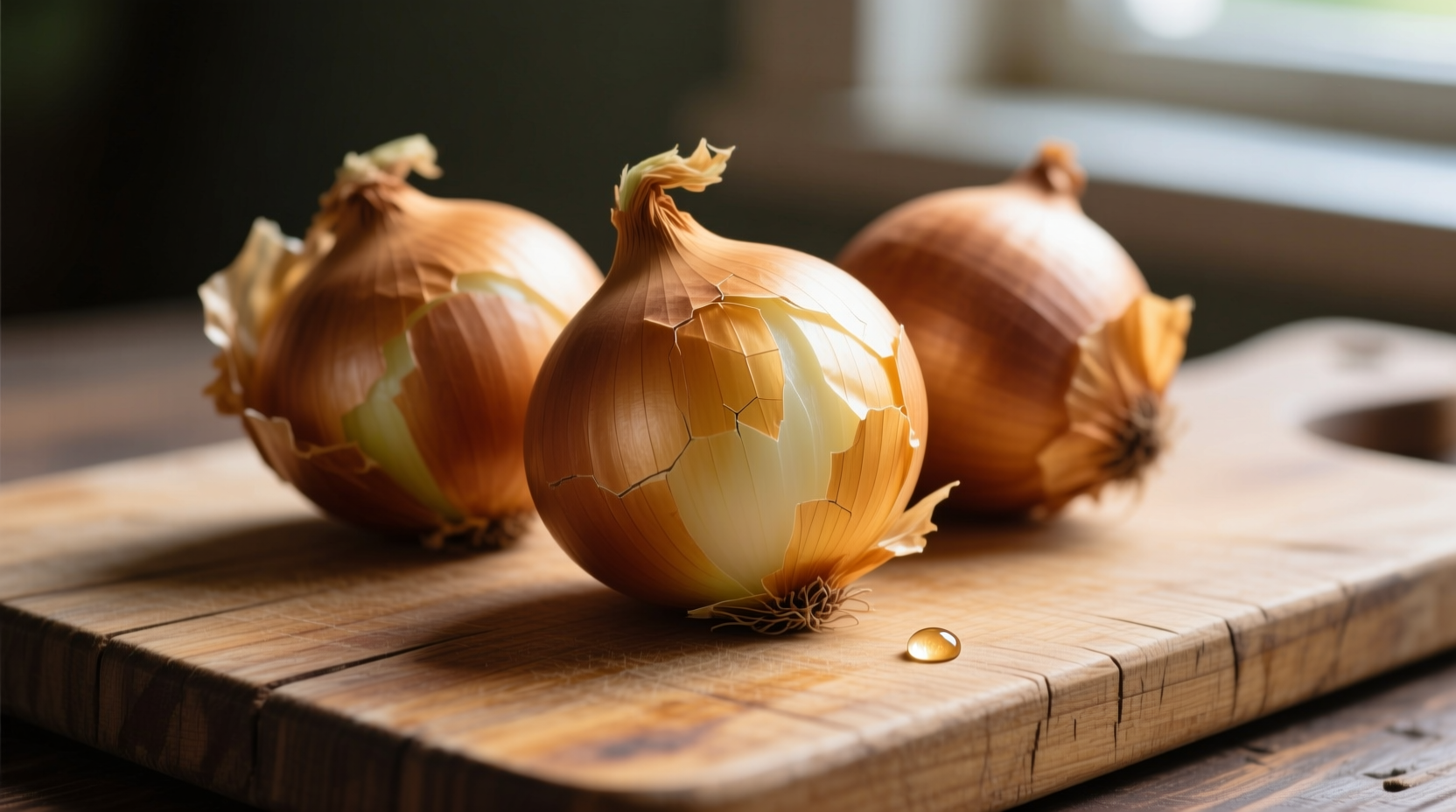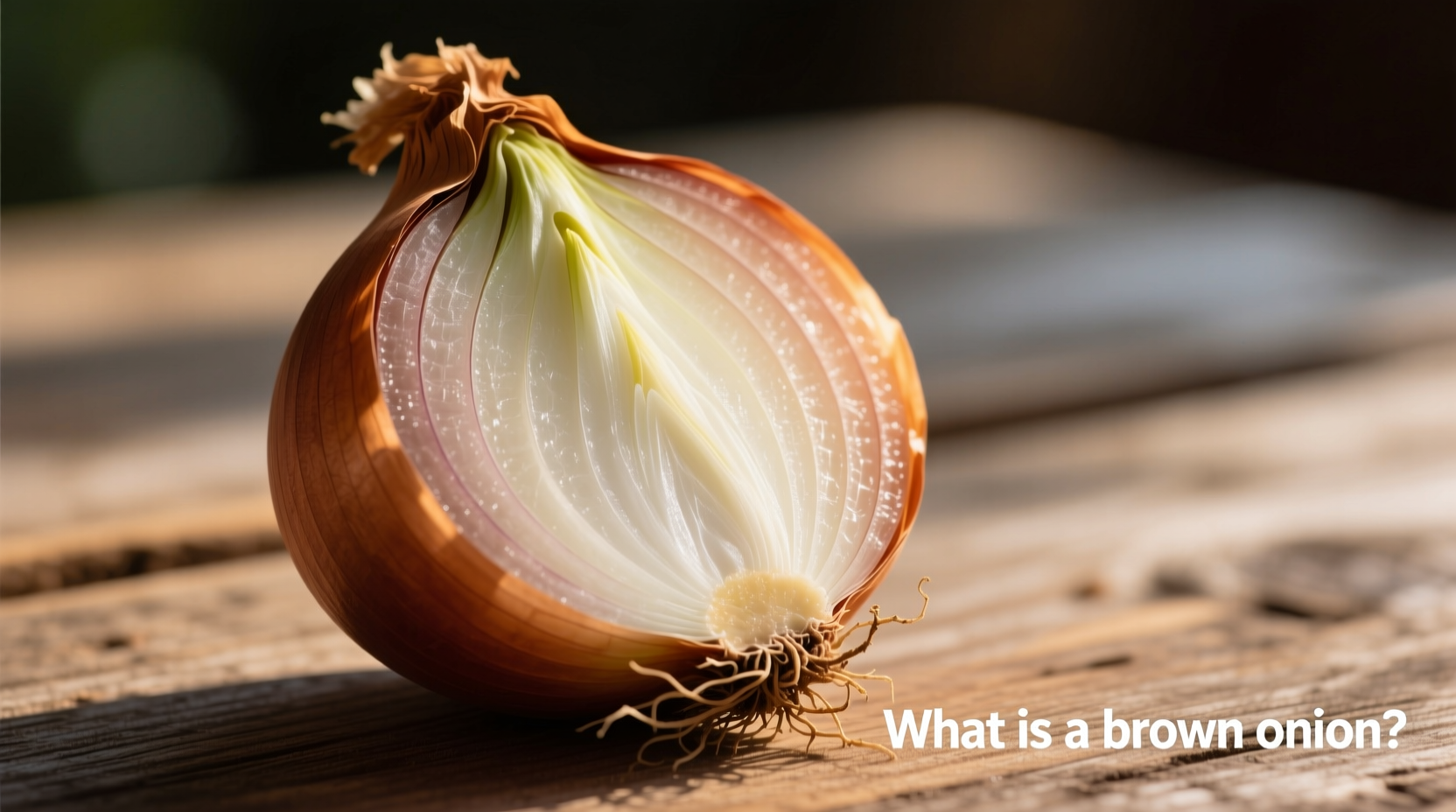A brown onion, also commonly called a yellow onion, is the most versatile cooking onion with a papery golden-brown skin and white to pale yellow flesh. It contains moderate sulfur compounds that create rich flavor when cooked, making it ideal for caramelizing, roasting, and sautéing in countless recipes worldwide.
Ever stood in the grocery store produce section wondering which onion to grab for your recipe? You're not alone. Understanding what a brown onion actually is—and why it's the workhorse of professional and home kitchens—can transform your cooking results. In this guide, you'll discover exactly what defines a brown onion, how it differs from other varieties, and when to use it for maximum flavor impact in your dishes.
Defining the Brown Onion: More Than Just a Color
Despite the name, brown onions aren't actually brown inside. The "brown" refers to their distinctive outer skin, which ranges from golden-tan to coppery-brown. Botanically classified as Allium cepa, these onions contain moderate levels of sulfur compounds that create their characteristic flavor profile when cut or cooked.
According to the USDA National Nutrient Database, a medium brown onion (148g) provides 64 calories, 15g of carbohydrates, and significant amounts of vitamin C, vitamin B6, and manganese. Their balanced sugar-to-sulfur ratio makes them exceptionally versatile across cooking methods.
| Onion Type | Outer Skin Color | Flavor Profile | Best Cooking Methods |
|---|---|---|---|
| Brown/Yellow | Golden-brown | Moderate pungency, sweetens when cooked | Caramelizing, roasting, soups, stews |
| White | Pale white | Sharp, clean bite | Salsas, Mexican cuisine, quick cooking |
| Red | Purple-red | Mild, slightly sweet | Salads, pickling, garnishes |
| Shallot | Coppery brown | Delicate, garlic-like | Vinaigrettes, sauces, fine dining |
Why Brown Onions Dominate Professional Kitchens
Chef instructors at culinary schools consistently teach that brown onions form the flavor foundation for 80% of savory dishes. Their higher sugar content (approximately 5-6% compared to 3-4% in white onions) creates superior caramelization, while their moderate sulfur compounds mellow beautifully during cooking.
When selecting brown onions, look for firm bulbs with dry, papery skins free of sprouts or soft spots. The National Onion Association recommends storing them in a cool, dark, well-ventilated space—never in plastic bags which trap moisture and accelerate spoilage. Properly stored, they maintain quality for 2-3 months.

Practical Applications: When to Reach for Brown Onions
Understanding the context boundaries for brown onions prevents recipe failures. They excel in applications requiring extended cooking time where flavor development matters most:
- Soup and sauce bases - Their flavor deepens beautifully during long simmers
- Caramelized applications - Superior browning compared to other varieties
- Roasted vegetable medleys - Complements root vegetables perfectly
- Meat braises - Adds complexity without overpowering
However, brown onions aren't ideal for raw applications where their sharper bite remains pronounced. For salads or quick salsas, red or sweet onions work better. The Food Safety and Inspection Service notes that cooking onions to 165°F (74°C) eliminates potential surface contaminants while preserving flavor compounds.
Smart Substitutions When Brown Onions Aren't Available
Ran out of brown onions mid-recipe? Understanding substitution ratios prevents dish disasters. While not perfect equivalents, these alternatives work in a pinch:
- White onions - Use 1:1 ratio but expect brighter, sharper flavor
- Sweet onions - Reduce quantity by 25% to avoid excessive sweetness
- Shallots - Use 1.5x quantity for similar flavor impact
- Red onions - Best for quick-cooking applications only
Professional chefs often combine onion varieties—using white onions for initial sautéing and finishing with a touch of red for complexity. This layered approach creates more nuanced flavor profiles than relying on a single type.
Maximizing Flavor: Pro Techniques for Brown Onions
How you cut and cook brown onions dramatically affects final flavor. Follow these evidence-based techniques:
- Cut against the grain - Slicing perpendicular to growth rings minimizes tear-inducing compounds
- Low-and-slow caramelization - Cook over medium-low heat for 30-40 minutes for deepest flavor
- Salt early - Drawing out moisture initially speeds caramelization later
- Add acid at the end - A splash of vinegar or wine balances sweetness
Research published in the Journal of Food Science confirms that cooking brown onions slowly with fat (like olive oil or butter) maximizes the development of 22 flavor compounds compared to high-heat methods that produce only 12-15 compounds.
Common Brown Onion Misconceptions Clarified
Several persistent myths confuse home cooks. Let's set the record straight with verified facts:
- Myth: Brown and yellow onions are different varieties
Fact: They're the same onion—"brown" refers to the skin color common in European markets, while "yellow" is the American term - Myth: Stronger smell means better flavor
Fact: Excessive pungency often indicates improper storage or age—ideal cooking onions have moderate aroma - Myth: All onions caramelize equally well
Fact: Brown onions contain the ideal sugar-to-sulfur ratio for caramelization—white onions burn easily, red onions turn unappetizing colors











 浙公网安备
33010002000092号
浙公网安备
33010002000092号 浙B2-20120091-4
浙B2-20120091-4